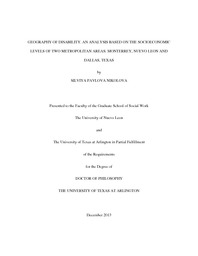
ATTENTION: The works hosted here are being migrated to a new repository that will consolidate resources, improve discoverability, and better show UTA's research impact on the global community. We will update authors as the migration progresses. Please see MavMatrix for more information.
Show simple item record
| dc.contributor.author | Nikolova, Silviya Pavlova | en_US |
| dc.date.accessioned | 2014-03-12T23:52:46Z | |
| dc.date.available | 2014-03-12T23:52:46Z | |
| dc.date.issued | 2014-03-12 | |
| dc.date.submitted | January 2013 | en_US |
| dc.identifier.other | DISS-12374 | en_US |
| dc.identifier.uri | http://hdl.handle.net/10106/24165 | |
| dc.description.abstract | This doctoral project investigated the performance of disability within two different political, cultural, and socioeconomic environments. Data were analyzed from decennial census data from Mexico (2010) and the U.S. (2000) that included a measure of disability prevalence and the activities on which disability status is assessed. In Chapter 1, the relevance of the study to the understanding of disability as a context-related matter was explained. Comparative statistics and scholarly reports on disability have been used to discuss the existing discrepancies between disability trends in developing and developed countries. An emphasis for a construction of multifactorial comparative model for disability research was proposed based on previous discussions on disability research. In Chapter 2, empirical and non-empirical literature was critically reviewed. Specifics on welfare inconsistency, program development, and policy implementation were detected with greater program and policy integration observed in the U.S. and greater advances in international disability human rights ratifications in Mexico. This study has added new critical context-related dimensions to the comparative research on disability and re-examined the existing knowledge base on disability beyond the Western horizon of disability understandings. In Chapter 3, the theoretical framework of the study was described. A combination of key concepts - (dis)advantaged environments and (dis)ability were discussed from the theoretical standpoint of Amartya Sen and Pierre Bourdieu. In Chapter 4, the research design was described, along with the methodology and rationale. A cross-sectional study design was employed using data from two national census data collections. Conceptual and methodological comparison of disability measurement was thoughtfully discussed and synchronized. Appropriate statistical procedures using GeoDa software for geospatial analysis and computation (version 13.0), and ArcGIS software for mapping and spatial analysis (version 10.1) were used.In Chapter 5, a descriptive analysis on the research population was initially conducted. Spatial econometric models (Global and Local Moran's Index) were used to measure the overall clustering of the data and to identify localized patterns of spatial autocorrelation. Spatial regression analysis (i.e. Spatial Lag and Spatial Error models) of the first hypothesis was subsequently conducted to eliminate the dependence effect in the data. A geographically weighted regression analysis of the second hypothesis was also conducted to test the aggregated effects of race and ethnicity on disability prediction in Monterrey and Dallas County. In Chapter 6, the study findings suggest focusing social work efforts towards creating a cohesive environment for individuals with disability on a community level. It also broadens the scope for cohesion to include adaptations for diverse minority groups of people with disabilities. The experience of people with disabilities who belong to minority groups is distinct and thus interventions directed towards them require adaptations. A move towards community empowerment would have a vital role in creating new strategies in disability interventions | en_US |
| dc.description.sponsorship | Bricout, John | en_US |
| dc.language.iso | en | en_US |
| dc.publisher | Social Work | en_US |
| dc.title | Geography Of Disability. An Analysis Based On The Socioeconomic Levels Of Two Metropolitan Areas: Monterrey, Nuevo Leon And Dallas, Texas | en_US |
| dc.type | Ph.D. | en_US |
| dc.contributor.committeeChair | Bricout, John | en_US |
| dc.degree.department | Social Work | en_US |
| dc.degree.discipline | Social Work | en_US |
| dc.degree.grantor | University of Texas at Arlington | en_US |
| dc.degree.level | doctoral | en_US |
| dc.degree.name | Ph.D. | en_US |
Files in this item
- Name:
- Nikolova_uta_2502D_12374.pdf
- Size:
- 3.397Mb
- Format:
- PDF
This item appears in the following Collection(s)
Show simple item record


